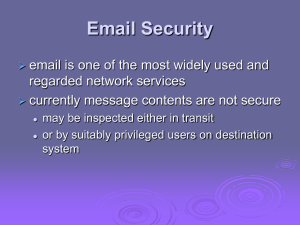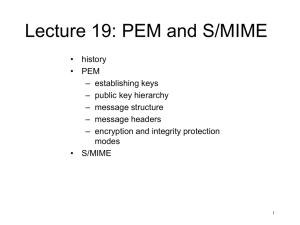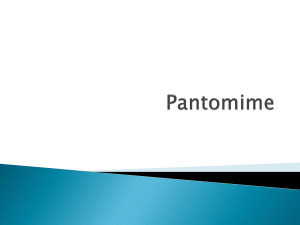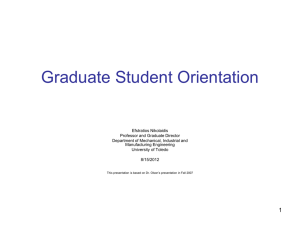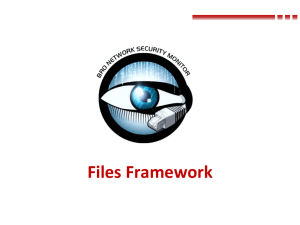William Stallings, Cryptography and Network Security 5/e
advertisement
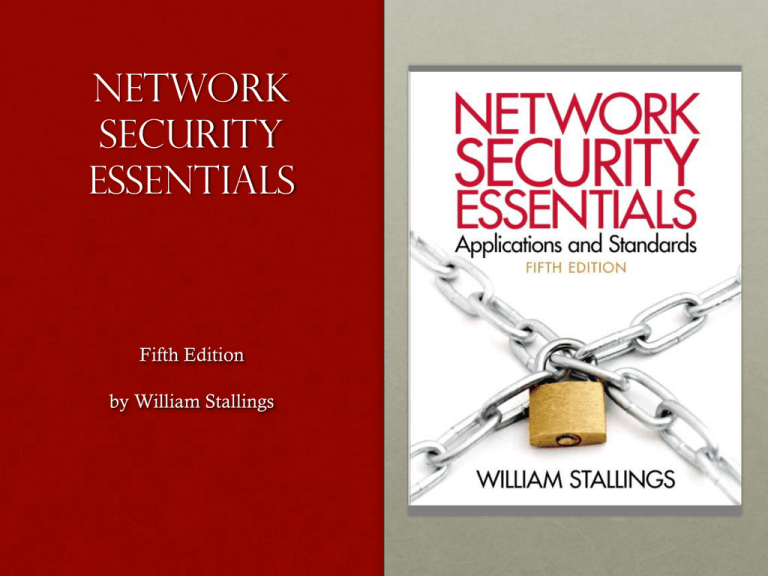
Network Security Essentials Fifth Edition by William Stallings Chapter 8 Electronic Mail Security “Despite the refusal of VADM Poindexter and LtCol North to appear, the Board's access to other sources of information filled much of this gap. The FBI provided documents taken from the files of the National Security Advisor and relevant NSC staff members, including messages from the PROF system between VADM Poindexter and LtCol North. The PROF messages were conversations by computer, written at the time events occurred and presumed by the writers to be protected from disclosure. In this sense, they provide a first-hand, contemporaneous account of events.” —The Tower Commission Report to President Reagan on the Iran-Contra Affair, 1987 Pretty Good Privacy (PGP) • Provides a confidentiality and authentication service that can be used for electronic mail and file storage applications • Developed by Phil Zimmermann • Selected the best available cryptographic algorithms as building blocks • Integrated these algorithms into a general-purpose application that is independent of operating system and processor and that is based on a small set of easy-to-use commands • Made the package and its documentation, including the source code, freely available via the Internet, bulletin boards, and commercial networks • Entered into an agreement with a company to provide a fully compatible, low-cost commercial version of PGP PGP Growth It is available free worldwide in versions that run on a variety of platforms The commercial version satisfies users who want a product that comes with vendor support It is based on algorithms that have survived extensive public review and are considered extremely secure It has a wide range of applicability It was not developed by, nor is it controlled by, any governmental or standards organization Is now on an Internet standards track, however it still has an aura of an antiestablishment endeavor Table 8.1 Summary of PGP Services PGP Authentication • Combination of SHA-1 and RSA provides an effective digital signature scheme • Because of the strength of RSA the recipient is assured that only the possessor of the matching private key can generate the signature • Because of the strength of SHA-1 the recipient is assured that no one else could generate a new message that matches the hash code • As an alternative, signatures can be generated using DSS/SHA-1 • Detached signatures are supported • Each person’s signature is independent and therefore applied only to the document PGP Confidentiality • Provided by encrypting messages to be transmitted or to be stored locally as files • In both cases the symmetric encryption algorithm CAST-128 may be used • Alternatively IDEA or 3DES may be used • The 64-bit cipher feedback (CFB) mode is used In PGP each symmetric key is used only once • Although referred to as a session key, it is in reality a one-time key • Session key is bound to the message and transmitted with it • To protect the key, it is encrypted with the receiver’s public key • As an alternative to the use of RSA for key encryption, PGP uses ElGamal, a variant of Diffie-Hellman that provides encryption/decryption PGP Confidentiality and Authentication • Both services may be used for the same message • First a signature is generated for the plaintext message and prepended to the message • Then the plaintext message plus signature is encrypted using CAST-128 (or IDEA or 3DES) and the session key is encrypted using RSA (or ElGamal) • When both services are used: The sender first signs the message with its own private key Then encrypts the message with a session key And finally encrypts the session key with the recipient’s public key PGP Compression • As a default, PGP compresses the message after applying the signature but before encryption • This has the benefit of saving space both for e-mail transmission and for file storage • The placement of the compression algorithm is critical • Applying the hash function and signature after compression would constrain all PGP implementations to the same version of the compression algorithm • Message encryption is applied after compression to strengthen cryptographic security • The compression algorithm used is ZIP PGP E-mail Compatibility • Many electronic mail systems only permit the use of blocks consisting of ASCII text • To accommodate this restriction, PGP provides the service of converting the raw 8-bit binary stream to a stream of printable ASCII characters • The scheme used for this purpose is radix-64 conversion • Each group of three octets of binary data is mapped into four ASCII characters • This format also appends a CRC to detect transmission errors Secure/Multipurpose Internet Mail Extension (S/MIME) • A security enhancement to the MIME Internet e-mail format standard based on technology from RSA Data Security • Defined in: • RFCs 3370, 3850, 3851, 3852 RFC 5322 • Defines a format for text messages that are sent using electronic mail • Messages are viewed as having an envelope and contents • The envelope contains whatever information is needed to accomplish transmission and delivery • The contents compose the object to be delivered to the recipient • RFC 5322 standard applies only to the contents • The content standard includes a set of header fields that may be used by the mail system to create the envelope Multipurpose Internet Mail Extensions (MIME) • An extension to the RFC 5322 framework that is intended to address some of the problems and limitations of the use of Simple Mail Transfer Protocol (SMTP) • Is intended to resolve these problems in a manner that is compatible with existing RFC 5322 implementations • The specification is provided in RFCs 2045 through 2049 MIME specification includes the following elements: Five new message header fields are defined, which may be included in an RFC 5322 header; these fields provide information about the body of the message Transfer encodings are defined that enable the conversion of any content format into a form that is protected from alteration by the mail system A number of content formats are defined, thus standardizing representations that support multimedia electronic mail The Five Header Fields Defined in MIME MIME-Version • Must have the parameter value 1.0 • This field indicates that the message conforms to RFCs 2045 and 2046 Content-Type • Describes the data contained in the body with sufficient detail that the receiving user agent can pick an appropriate agent or mechanism to represent the data to the user or otherwise deal with the data in an appropriate manner Content-Transfer-Encoding • Indicates the type of transformation that has been used to represent the body of the message in a way that is acceptable for mail transport Content-ID • Used to identify MIME entities uniquely in multiple contexts Content-Description • A text description of the object with the body; this is useful when the object is not readable Table 8.2 MIME Content Types Table 8.3 MIME Transfer Encodings Figure 8.3 Example MIME Message Structure Table 8.4 Native and Canonical Form S/MIME Functionality Enveloped data • Consists of encrypted content of any type and encrypted content encryption keys for one or more recipients Signed data • A digital signature is formed by taking the message digest of the content to be signed and then encrypting that with the private key of the signer • The content plus signature are then encoded using base64 encoding • A signed data message can only be viewed by a recipient with S/MIME capability S/MIME Clear-signed data • Only the digital signature is encoded using base64 • As a result recipients without S/MIME capability can view the message content, although they cannot verify the signature Signed and enveloped data • Signed-only and encrypted-only entities may be nested, so that encrypted data may be signed and signed data or clear-signed data may be encrypted Table 8.5 Cryptographic Algorithms Used in S/MIME Table 8.6 S/MIME Content Types Securing a MIME Entity • S/MIME secures a MIME entity with a signature, encryption, or both • The MIME entity is prepared according to the normal rules for MIME message preparation • The MIME entity plus some security-related data, such as algorithm identifiers and certificates, are processed by S/MIME to produce what is known as a PKCS object • A PKCS object is then treated as message content and wrapped in MIME • In all cases the message to be sent is converted to canonical form Enveloped Data • The steps for preparing an EnvelopedData MIME are: Generate a pseudorandom session key for a particular symmetric encryption algorithm For each recipient, encrypt the session key with the recipient’s public RSA key For each recipient, prepare a block known as RecipientInfo that contains an identifier of the recipient’s public-key certificate, an identifier of the algorithm used to encrypt the session key, and the encrypted session key Encrypt the message content with the session key Signed Data • The steps for preparing a SignedData MIME are: Compute the message digest (hash function) of the content to be signed Select a message digest algorithm (SHA or MD5) Encrypt the message digest with the signer’s private key Prepare a block known as SignerInfo that contains the signer’s publickey certificate, an identifier of the message digest algorithm, an identifier of the algorithm used to encrypt the message digest, and the encrypted message digest Clear Signing • Achieved using the multipart content type with a signed subtype • This signing process does not involve transforming the message to be signed • Recipients with MIME capability but not S/MIME capability are able to read the incoming message S/MIME Certificate Processing • S/MIME uses public-key certificates that conform to version 3 of X.509 • The key-management scheme used by S/MIME is in some ways a hybrid between a strict X.509 certification hierarchy and PGP’s web of trust • S/MIME managers and/or users must configure each client with a list of trusted keys and with certificate revocation lists • The responsibility is local for maintaining the certificates needed to verify incoming signatures and to encrypt outgoing messages • The certificates are signed by certification authorities User Agent Role • An S/MIME user has several key-management functions to perform: Key generation Registration The user of some related administrative utility must be capable of generating separate Diffie-Hellman and DSS key pairs and should be capable of generating RSA key pairs A user’s public key must be registered with a certification authority in order to receive an X.509 public-key certificate A user agent should generate RSA key pairs with a length in the range of 768 to 1024 bits and must not generate a length of less than 512 bits Certificate storage and retrieval A user requires access to a local list of certificates in order to verify incoming signatures and to encrypt outgoing messages VeriSign Certificates • VeriSign provides a certification authority (CA) service that is intended to be compatible with S/MIME and a variety of other applications • Issues X.509 certificates with the product name VeriSign Digital ID • At a minimum, each Digital ID contains: • • • • • • Owner’s public key Owner’s name or alias Expiration date of the Digital ID Serial number of the Digital ID Name of the certification authority that issued the Digital ID Digital signature of the certification authority that issued the Digital ID Table 8.7 VeriSign Public-Key Certificate Classes IA CA PCA PIN LRAA Issuing Authority Certification Authority VeriSign public primary certification authority Personal Identification Number Local Registration Authority Administrator Enhanced Security Services • Three enhanced security services have been proposed in an Internet draft: Signed receipt • Returning a signed receipt provides proof of delivery to the originator of a message and allows the originator to demonstrate to a third party that the recipient received the message Security labels • A set of security information regarding the sensitivity of the content that is protected by S/MIME encapsulation Secure mailing lists • An S/MIME Mail List Agent (MLA) can take a single incoming message, perform the recipient-specific encryption for each recipient, and forward the message DomainKeys Identified Mail (DKIM) • A specification for cryptographically signing e-mail messages, permitting a signing domain to claim responsibility for a message in the mail stream • Message recipients can verify the signature by querying the signer’s domain directly to retrieve the appropriate public key and can thereby confirm that the message was attested to by a party in possession of the private key for the signing domain • Proposed Internet Standard RFC 4871 • Has been widely adopted by a range of e-mail providers and Internet Service Providers (ISPs) E-mail Threats • RFC 4684 (Analysis of Threats Motivating DomainKeys Identified Mail) • Describes the threats being addressed by DKIM in terms of the characteristics, capabilities, and location of potential attackers • Characterized on three levels of threat: The most sophisticated and financially motivated senders of messages are those who stand to receive substantial financial benefit, such as from an e-mail based fraud scheme The next level are professional senders of bulk spam mail and often operate as commercial enterprises and send messages on behalf of third parties At the low end are attackers who simply want to send e-mail that a recipient does not want to receive Summary • Pretty good privacy • Notation • Operational description • DomainKeys Identified Mail • • • • Internet mail architecture E-mail threats DKIM strategy DKIM functional flow • S/MIME • RFC 5322 • Multipurpose Internet mail extensions • S/MIME functionality • S/MIME messages • S/MIME certification processing • Enhanced security services

